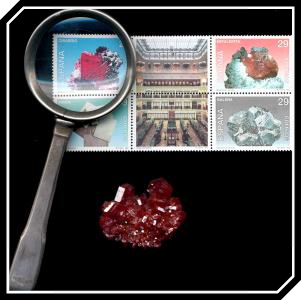Updated June 2025
La Terra dietro una lente.
Francobolli di minerali, meteoriti e gemme
FDC di minerali e gemme
The earth behind a lens
Minerals, Meteorite and Gemstone Stamps -
FDC of minerals and gems

Come ogni cosa i minerali sono formati da minuscole particelle chimiche
(atomi e molecole) ordinate come le stanze di un grattacielo.
Ciò consente al minerale di crescere, talvolta, in forma di solidi geometrici con facce regolari e piane. Queste forme naturali si chiamano cristalli. I cristalli dei minerali si presentano in un’infinità di forme diverse. Alcuni formano cubi, altri s’innalzano in colonne con tre o più facce, dette prismi, altri ancora formano forme solide complesse.
Da sempre l'uomo raccoglie rocce e minerali per utilizzarli in vari modi: li trasforma in utensili, li sfrutta come combustibili, li impiega come materiali da costruzione, ne ricava ornamenti e gioielli; ma li colleziona anche per studiarli, per comprendere attraverso di essi la struttura e la storia della Terra.
Il mondo minerale, forma l’insieme delle rocce del nostro pianeta.
Dovunque tu viva, in città, in campagna, in montagna o sulla riva del mare, i minerali sono sempre attorno a te. Sono nelle pietre del muro della tua casa, nella copertura dei tetti, sui bordi dei sentieri, nelle rocce lungo la strada, nella sabbia e nei ciottoli della spiaggia. Fanno parte della tua vita quotidiana.
A maggio 2025 vi sono più di 6.100 specie minerali conosciute
In questa sezione riportiamo i francobolli emessi dai vari stati che ritraggono
i minerali, le meteoriti e le gemme.
Like everything, minerals are made up of tiny chemical particles
(atoms and molecules) ordered like the rooms of a skyscraper.
This allows the mineral to grow, sometimes, in the form of geometric solids with regular, flat faces. These natural forms are called crystals. Mineral crystals come in a multitude of different forms.
Some form cubes, others rise in columns with three or more faces, called prisms, and still others form complex solid shapes.
Since man always collects rocks and minerals to use them in various ways: he transforms them into tools, exploits them as fuels, uses them as building materials, obtains ornaments and jewels from them; but he also collects them to study them, to understand through them the structure and history of the Earth.
The mineral world forms the whole of the rocks of our planet.
Wherever you live, in the city, in the countryside, in the mountains or on the seashore, minerals are always around you.
They are in the stones of the wall of your house, in the covering of the roofs, in the edges of the paths, in the rocks along the road, in the sand and pebbles of the beach. They are part of your daily life.
In this section we report the stamps issued by the various countries that portray
minerals, meteorites and gems.
Italy 2025 - Property of Odino Grubessi & Mario Ramus